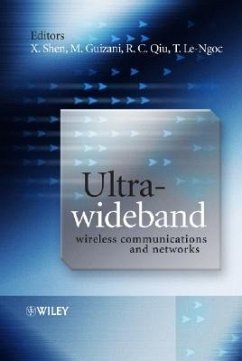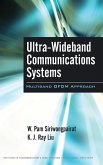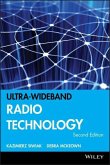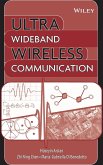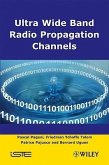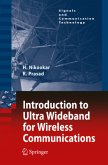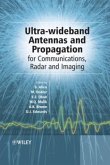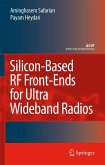Ultra-Wideband Wireless Communications and Networks
Herausgeber: Shen, Xuemin; Le-Ngoc, Tho; Qiu, Robert Caiming; Guizani, Mohsen
Ultra-Wideband Wireless Communications and Networks
Herausgeber: Shen, Xuemin; Le-Ngoc, Tho; Qiu, Robert Caiming; Guizani, Mohsen
- Gebundenes Buch
- Merkliste
- Auf die Merkliste
- Bewerten Bewerten
- Teilen
- Produkt teilen
- Produkterinnerung
- Produkterinnerung
Ultra-wideband (UWB) technology has great potential for applications in wireless communications, radar and location. It has many benefits due to its ultra-wideband nature, which include high data rate, less path loss and better immunity to multipath propagation, availability of low-cost transceivers, low transmit power and low interference. Despite R&D results so far demonstrating that UWB radio is a promising solution for high-rate short-range wireless communications, further extensive investigation is necessary towards developing effective and efficient UWB communication systems and UWB…mehr
Andere Kunden interessierten sich auch für
![Ultra-Wideband Communications Systems Ultra-Wideband Communications Systems]() W. Pam SiriwongpairatUltra-Wideband Communications Systems199,99 €
W. Pam SiriwongpairatUltra-Wideband Communications Systems199,99 €![Ultra-Wideband Radio Technology Ultra-Wideband Radio Technology]() Kazimierz SiwiakUltra-Wideband Radio Technology146,99 €
Kazimierz SiwiakUltra-Wideband Radio Technology146,99 €![Ultra Wideband Wireless Communication Ultra Wideband Wireless Communication]() Huseyin ArslanUltra Wideband Wireless Communication176,99 €
Huseyin ArslanUltra Wideband Wireless Communication176,99 €![Ultra-Wideband Radio Propagation Channels Ultra-Wideband Radio Propagation Channels]() Pascal PaganiUltra-Wideband Radio Propagation Channels186,99 €
Pascal PaganiUltra-Wideband Radio Propagation Channels186,99 €![Introduction to Ultra Wideband for Wireless Communications Introduction to Ultra Wideband for Wireless Communications]() Homayoun NikookarIntroduction to Ultra Wideband for Wireless Communications108,99 €
Homayoun NikookarIntroduction to Ultra Wideband for Wireless Communications108,99 €![Ultra-Wideband Antennas and Propagation Ultra-Wideband Antennas and Propagation]() Ben Allen / Mischa Dohler / Ernest Okon / Wasim Malik / Anthony Brown / David Edwards (eds.)Ultra-Wideband Antennas and Propagation199,99 €
Ben Allen / Mischa Dohler / Ernest Okon / Wasim Malik / Anthony Brown / David Edwards (eds.)Ultra-Wideband Antennas and Propagation199,99 €![Silicon-Based RF Front-Ends for Ultra Wideband Radios Silicon-Based RF Front-Ends for Ultra Wideband Radios]() Aminghasem SafarianSilicon-Based RF Front-Ends for Ultra Wideband Radios77,99 €
Aminghasem SafarianSilicon-Based RF Front-Ends for Ultra Wideband Radios77,99 €-
-
-
Ultra-wideband (UWB) technology has great potential for applications in wireless communications, radar and location. It has many benefits due to its ultra-wideband nature, which include high data rate, less path loss and better immunity to multipath propagation, availability of low-cost transceivers, low transmit power and low interference. Despite R&D results so far demonstrating that UWB radio is a promising solution for high-rate short-range wireless communications, further extensive investigation is necessary towards developing effective and efficient UWB communication systems and UWB technology. Ultra-wideband Wireless Communications and Networks explores both the fundamental aspects and the more advanced topics of networks and applications. Challenges and up-to-date technical progress in the field are presented, with timely reporting of results from cutting-edge research and state-of-the-art technology in UWB wireless communications. * Unique focus on UWB wireless communications rather than previously covered UWB radar aspects. * Topics include: radio propagation and large scale variations, pulse propagation and channel modelling, MIMO (Multiple Input - Multiple Output) RF subsystems and ad hoc networks. * Features a wealth of tables, illustrations and photographs. This book is aimed at professionals wishing to enhance their knowledge of UWB wireless communications systems for short range communications. It will also appeal to senior undergraduate and graduate students who require information on the key topics in this area.
Hinweis: Dieser Artikel kann nur an eine deutsche Lieferadresse ausgeliefert werden.
Hinweis: Dieser Artikel kann nur an eine deutsche Lieferadresse ausgeliefert werden.
Produktdetails
- Produktdetails
- Verlag: Wiley
- Seitenzahl: 320
- Erscheinungstermin: 1. April 2006
- Englisch
- Abmessung: 251mm x 174mm x 25mm
- Gewicht: 762g
- ISBN-13: 9780470011447
- ISBN-10: 0470011440
- Artikelnr.: 22781253
- Herstellerkennzeichnung
- Libri GmbH
- Europaallee 1
- 36244 Bad Hersfeld
- gpsr@libri.de
- Verlag: Wiley
- Seitenzahl: 320
- Erscheinungstermin: 1. April 2006
- Englisch
- Abmessung: 251mm x 174mm x 25mm
- Gewicht: 762g
- ISBN-13: 9780470011447
- ISBN-10: 0470011440
- Artikelnr.: 22781253
- Herstellerkennzeichnung
- Libri GmbH
- Europaallee 1
- 36244 Bad Hersfeld
- gpsr@libri.de
Professor Xuemin Shen works in the Department of Electrical and Computer Engineering at the University of Waterloo, Canada. His research interests are Wireless/Internet interworking, Resource and mobility management, Voice over mobile IP, WiFi, WAP, Bluetooth, UWB wireless applications, ad hoc wireless networks. Dr. Mohsen Guizani is Professor and Chair of the Department of Computer Science at Western Michigan university. Dr. Guizani's research interests include Computer Networks, Wireless Communications and Computing, Design and Analysis of Computer Systems, and Optical Networking. He is the founder and Editor-In-Chief of Wireless Communications and Mobile Computing Journal, published by John Wiley. Professor Robert Caiming works in the Center for Manufacturing Research/Electrical and Computer Engineering Department at Tennessee Technological University, USA. His research interests include Wireless communications and systems (3G, 4G, UWB), Radar/communications signal processing and Time-domain Electromagnetics. Professor Tho Le-Ngoc works in the Department of Electrical and Computer Engineering at McGill University. His research interests include Broadband Communications: Advanced Transmission, Multiple-Access and Dynamic Capacity Allocation Techniques.
List of Contributors xi
Preface xiii
1 Introduction 1
Robert Caiming Qiu, Xuemin (Sherman) Shen, Mohsen Guizani and Tho Le-Ngoc
1.1 Fundamentals 1
1.1.1 Overview of UWB 1
1.1.2 History 2
1.1.3 Regulatory 2
1.1.4 Applications 2
1.1.5 Pulse- or Multicarrier-Based UWB 3
1.2 Issues Unique to UWB 4
1.2.1 Antennas 4
1.2.2 Propagation and Channel Model 4
1.2.3 Modulations 5
1.2.4 A/D Sampling 6
1.2.5 Timing Acquisition 7
1.2.6 Receiver Structures 7
1.2.7 Multiple Access 8
1.3 Emerging Technologies 8
1.3.1 Low-Complexity Noncoherent Receivers 8
1.3.2 Location-Based Sensor Networks 9
1.3.3 Time Reversal 9
1.3.4 MAC 10
1.3.5 Future Directions 12
References 13
2 Modulation and Signal Detection in UWB 15
Uzoma A. Onunkwo and Ye (Geoffrey) Li
2.1 Overview 15
2.1.1 Evolution and Definition 15
2.1.2 Major Differences from Narrowband and CDMA Systems 16
2.1.3 Types of UWB Modulation 16
2.1.4 UWB Applications 16
2.2 Single-Carrier-Based Modulation 17
2.2.1 Time-Hopping PPM 17
2.2.2 Other Types of Modulations 21
2.2.3 Channel Estimation 23
2.2.4 Signal Detection 27
2.3 OFDM-Based Modulation 29
2.3.1 Basic OFDM for UWB 29
2.3.2 Channel Estimation 30
2.3.3 Interference Suppression 31
2.4 Conclusion and Further Reading 34
References 34
3 UWB Pulse Propagation and Detection 37
Robert Caiming Qiu
3.1 Introduction 37
3.2 UWB Pulse Propagation 37
3.2.1 Generalized Multipath Model 37
3.2.2 IEEE 802.15.4a Channel Model 39
3.3 UWB Pulse Signal Detection 39
3.3.1 Optimum Receiver 39
3.3.2 Generalized RAKE Receiver 41
3.3.3 Optimum Receiver with Intersymbol Interference 44
3.3.4 Receiver with Time-Reversal Channel Impulse Response 47
3.3.5 Optimum Receiver with Multiuser Detection 48
References 51
4 Timing Synchronization for UWB Impulse Radios 53
Zhi Tian and Georgios B. Giannakis
4.1 Introduction 53
4.2 Signal Model 55
4.3 Signal Detection and Symbol-Level Acquisition 57
4.3.1 Analog Energy Detectors 57
4.3.2 Discrete-Time Energy Detectors 57
4.4 SAT and MAT: Templates with and without Timing 59
4.5 Coarse Synchronization Using Symbol-Rate Samples 60
4.5.1 Discrete-Time Correlator Output Model under Mistiming 61
4.5.2 CML Timing Synchronization 62
4.5.3 Analytic and Simulated Performance 62
4.6 Synchronization with Flexible Timing Resolution 64
4.6.1 Timing-Offset Search via Sample Mean Square 64
4.6.2 Timing-Offset Search via Cross-Correlation Mean Square 66
4.6.3 Comparative Study and Implementation Aspects 68
4.7 Timing Acquisition for Ad Hoc Multiple Access 70
4.7.1 Training-Based Multiuser TOE 70
4.7.2 Blind Synchronization for Multiuser Ad Hoc Access 71
4.7.3 TOE Performance Analysis 75
4.8 Demodulation and BER Sensitivity to Mistiming 76
4.9 Concluding Summary 78
References 79
5 Error Performance of Pulsed Ultra-wideband Systems in Indoor Environments
83
Huaping Liu
5.1 Introduction 83
5.2 System Model 85
5.3 Error Performance in Indoor Environments 89
5.3.1 Pulse Amplitude Modulation and Pulse Position Modulation 90
5.3.2 Receiver with Self-Derived Template Waveforms 92
5.3.3 System with Multiple Antennas 95
References 101
6 Mixed-Signal Ultra-wideband Communications Receivers 103
Sebastian Hoyos and Brian M. Sadler
6.1 Introduction 103
6.2 Analog-to-Digital Conversion via Signal Expansion 105
6.3 Mixed-Signal Communication Receivers Based on A/D Conversion via Signal
Expansion 107
6.3.1 Transmitted Signal and Channel Model 107
6.3.2 Digital Linear Receivers Based on ADC via Signal Expansion 107
6.4 Analog-to-Digital Conversion in the Frequency Domain 109
6.5 Frequency-Domain Mixed-Signal Receivers 111
6.5.1 Multicarrier Communication Systems Based on A/D Conversion in the
Frequency Domain 111
6.5.2 Relationship to the Fourier Series Coefficients 117
6.5.3 Mixed-Signal Transmitted-Reference Receiver 118
6.6 Conclusions 124
References 125
7 Trends in Ultra-wideband Transceiver Design 127
Zhengyuan Xu
7.1 Introduction 127
7.2 Status of UWB Transceiver Design 128
7.3 Digital UWB Receivers 130
7.3.1 PPM-Based TH-UWB System Model 131
7.3.2 Channel Estimation Techniques 132
7.3.3 Design of Linear Receivers 133
7.3.4 Some Thoughts about Complexity Reduction 134
7.3.5 Finite Resolution Digital Receivers 135
7.4 Analog/Digital UWB Transceivers 136
7.4.1 Near Full-Rate TR Transceivers 136
7.4.2 Full-Rate TR Transceivers 144
7.5 Conclusions 149
Acknowledgments 149
References 149
8 UWB MAC and Ad Hoc Networks 155
Zihua Guo and Richard Yao
8.1 Introduction 155
8.1.1 Overview of IEEE 802.15.3 MAC 155
8.1.2 Overview of MBOA MAC 157
8.2 QoS Scheduling in PNC 158
8.2.1 Problem Definition 159
8.2.2 Deadline-Aware Scheduling Algorithm 160
8.2.3 Calculation of the Reserved CTA 161
8.2.4 Simulation Results 161
8.3 Power Management in IEEE 802.15.3 163
8.3.1 Problem Definition 164
8.3.2 Proposed Approach 165
8.3.3 Simulation Results 167
8.4 Adaptive Dly-ACK 168
8.4.1 Problem Definition 170
8.4.2 Adaptive Dly-ACK 172
8.4.3 Simulation Results 177
8.5 Ad Hoc Networks 183
8.5.1 Child Piconet 183
8.5.2 Independent Piconets 184
8.6 Summary 187
References 187
9 Radio Resource Management for Ultra-wideband Communications 189
Xuemin (Sherman) Shen, Weihua Zhuang, Hai Jiang and Jun Cai
9.1 Introduction 189
9.2 Radio Resource Management 191
9.2.1 Pulse-Based UWB Physical Layer Characteristics 191
9.2.2 Challenges and Opportunities 192
9.3 Multiple Access 193
9.3.1 Exclusive versus Concurrent Transmissions 193
9.3.2 Code Assignment 194
9.3.3 Interference Mitigation in TH-UWB 196
9.4 Overhead Reduction 197
9.4.1 ACK Mechanisms 198
9.4.2 Long Acquisition Time 199
9.5 Power/Rate Allocation 200
9.5.1 Power Allocation 200
9.5.2 Rate Guarantee 202
9.5.3 Rate Control 203
9.5.4 Cross-Layer Design 205
9.6 Conclusions 206
References 207
10 Pulsed UWB Interference to Narrowband Receivers 211
Jay E. Padgett
10.1 Introduction 211
10.2 Pulsed UWB Signal Model 212
10.3 Narrowband Receiver Model 216
10.4 Equivalent Receiver Model and Response to a Pulse 218
10.5 Response to a Pulse Sequence 220
10.6 Simulating the Response to a Pulse Sequence 223
10.6.1 I/Q Component Formulation 223
10.6.2 Simulation Parameters 224
10.6.3 Normalization 224
10.6.4 Example Filter Response: The n-Pole Filter 225
10.7 General Properties of the IF Output 227
10.7.1 Case 1: Pulse Rate Less than IF Bandwidth 227
10.7.2 Case 2: Pulse Rate Greater than IF Bandwidth 228
10.8 Power Spectral Density 230
10.9 Discrete PDF PSD Example: Equally Spaced, Equally Likely Time Offsets
233
10.10 Continuous PDF PSD Examples 239
10.10.1 The Poisson Process 239
10.10.2 Continuous PDF Uniform Random Pulse Position 240
10.11 Comparison of PSD and Simulation Results 242
10.12 Statistical Properties of the Output Envelope 247
10.13 Summary 249
References 250
11 Digital-Carrier Spreading Codes for Baseband UWB Multiaccess 251
Liuqing Yang and Georgios B. Giannakis
11.1 Introduction 251
11.2 Digital-Carrier Multiband User Codes 252
11.2.1 Baseband Single-Carrier UWB 252
11.2.2 Baseband Multicarrier UWB 254
11.3 Low Duty-Cycle Access in the Presence of NBI 255
11.3.1 General Rake Reception Model 255
11.3.2 SINR Analysis 259
11.3.3 Simulations and Numerical Results 260
11.4 Improved Rate Access in the Presence of Multipath 263
11.4.1 Rake Reception Model with IFI 263
11.4.2 Performance Comparisons 266
11.4.3 Simulated Examples 271
11.5 Multiuser Interference Mitigation 273
11.6 Summary 276
References 276
12 Localization 279
Kegen Yu, Harri Saarnisaari, Jean-Philippe Montillet, Alberto Rabbachin,
Ian Oppermann and Giuseppe Thadeu Freitas de Abreu
12.1 Introduction 279
12.2 Time-of-Arrival Estimation 279
12.2.1 Estimation Accuracy 280
12.2.2 Energy-Collection-Based TOA Estimation 281
12.2.3 Two-Stage TOA Estimation 282
12.2.4 Simulation Results 286
12.3 Location and Tracking 286
12.3.1 Position Estimation 287
12.3.2 Tracking 292
12.3.3 Simulation Results 292
12.4 Location in Distributed Architectures 294
12.4.1 Overview 294
12.4.2 Proposed Algorithm 295
12.4.3 Simulation Results 296
12.5 Theoretical Positioning Accuracy 297
12.5.1 Analysis Tool 298
12.5.2 Hyperbolic Location Accuracy 299
12.6 Conclusions 301
Acknowledgment 301
References 301
Index 305
Preface xiii
1 Introduction 1
Robert Caiming Qiu, Xuemin (Sherman) Shen, Mohsen Guizani and Tho Le-Ngoc
1.1 Fundamentals 1
1.1.1 Overview of UWB 1
1.1.2 History 2
1.1.3 Regulatory 2
1.1.4 Applications 2
1.1.5 Pulse- or Multicarrier-Based UWB 3
1.2 Issues Unique to UWB 4
1.2.1 Antennas 4
1.2.2 Propagation and Channel Model 4
1.2.3 Modulations 5
1.2.4 A/D Sampling 6
1.2.5 Timing Acquisition 7
1.2.6 Receiver Structures 7
1.2.7 Multiple Access 8
1.3 Emerging Technologies 8
1.3.1 Low-Complexity Noncoherent Receivers 8
1.3.2 Location-Based Sensor Networks 9
1.3.3 Time Reversal 9
1.3.4 MAC 10
1.3.5 Future Directions 12
References 13
2 Modulation and Signal Detection in UWB 15
Uzoma A. Onunkwo and Ye (Geoffrey) Li
2.1 Overview 15
2.1.1 Evolution and Definition 15
2.1.2 Major Differences from Narrowband and CDMA Systems 16
2.1.3 Types of UWB Modulation 16
2.1.4 UWB Applications 16
2.2 Single-Carrier-Based Modulation 17
2.2.1 Time-Hopping PPM 17
2.2.2 Other Types of Modulations 21
2.2.3 Channel Estimation 23
2.2.4 Signal Detection 27
2.3 OFDM-Based Modulation 29
2.3.1 Basic OFDM for UWB 29
2.3.2 Channel Estimation 30
2.3.3 Interference Suppression 31
2.4 Conclusion and Further Reading 34
References 34
3 UWB Pulse Propagation and Detection 37
Robert Caiming Qiu
3.1 Introduction 37
3.2 UWB Pulse Propagation 37
3.2.1 Generalized Multipath Model 37
3.2.2 IEEE 802.15.4a Channel Model 39
3.3 UWB Pulse Signal Detection 39
3.3.1 Optimum Receiver 39
3.3.2 Generalized RAKE Receiver 41
3.3.3 Optimum Receiver with Intersymbol Interference 44
3.3.4 Receiver with Time-Reversal Channel Impulse Response 47
3.3.5 Optimum Receiver with Multiuser Detection 48
References 51
4 Timing Synchronization for UWB Impulse Radios 53
Zhi Tian and Georgios B. Giannakis
4.1 Introduction 53
4.2 Signal Model 55
4.3 Signal Detection and Symbol-Level Acquisition 57
4.3.1 Analog Energy Detectors 57
4.3.2 Discrete-Time Energy Detectors 57
4.4 SAT and MAT: Templates with and without Timing 59
4.5 Coarse Synchronization Using Symbol-Rate Samples 60
4.5.1 Discrete-Time Correlator Output Model under Mistiming 61
4.5.2 CML Timing Synchronization 62
4.5.3 Analytic and Simulated Performance 62
4.6 Synchronization with Flexible Timing Resolution 64
4.6.1 Timing-Offset Search via Sample Mean Square 64
4.6.2 Timing-Offset Search via Cross-Correlation Mean Square 66
4.6.3 Comparative Study and Implementation Aspects 68
4.7 Timing Acquisition for Ad Hoc Multiple Access 70
4.7.1 Training-Based Multiuser TOE 70
4.7.2 Blind Synchronization for Multiuser Ad Hoc Access 71
4.7.3 TOE Performance Analysis 75
4.8 Demodulation and BER Sensitivity to Mistiming 76
4.9 Concluding Summary 78
References 79
5 Error Performance of Pulsed Ultra-wideband Systems in Indoor Environments
83
Huaping Liu
5.1 Introduction 83
5.2 System Model 85
5.3 Error Performance in Indoor Environments 89
5.3.1 Pulse Amplitude Modulation and Pulse Position Modulation 90
5.3.2 Receiver with Self-Derived Template Waveforms 92
5.3.3 System with Multiple Antennas 95
References 101
6 Mixed-Signal Ultra-wideband Communications Receivers 103
Sebastian Hoyos and Brian M. Sadler
6.1 Introduction 103
6.2 Analog-to-Digital Conversion via Signal Expansion 105
6.3 Mixed-Signal Communication Receivers Based on A/D Conversion via Signal
Expansion 107
6.3.1 Transmitted Signal and Channel Model 107
6.3.2 Digital Linear Receivers Based on ADC via Signal Expansion 107
6.4 Analog-to-Digital Conversion in the Frequency Domain 109
6.5 Frequency-Domain Mixed-Signal Receivers 111
6.5.1 Multicarrier Communication Systems Based on A/D Conversion in the
Frequency Domain 111
6.5.2 Relationship to the Fourier Series Coefficients 117
6.5.3 Mixed-Signal Transmitted-Reference Receiver 118
6.6 Conclusions 124
References 125
7 Trends in Ultra-wideband Transceiver Design 127
Zhengyuan Xu
7.1 Introduction 127
7.2 Status of UWB Transceiver Design 128
7.3 Digital UWB Receivers 130
7.3.1 PPM-Based TH-UWB System Model 131
7.3.2 Channel Estimation Techniques 132
7.3.3 Design of Linear Receivers 133
7.3.4 Some Thoughts about Complexity Reduction 134
7.3.5 Finite Resolution Digital Receivers 135
7.4 Analog/Digital UWB Transceivers 136
7.4.1 Near Full-Rate TR Transceivers 136
7.4.2 Full-Rate TR Transceivers 144
7.5 Conclusions 149
Acknowledgments 149
References 149
8 UWB MAC and Ad Hoc Networks 155
Zihua Guo and Richard Yao
8.1 Introduction 155
8.1.1 Overview of IEEE 802.15.3 MAC 155
8.1.2 Overview of MBOA MAC 157
8.2 QoS Scheduling in PNC 158
8.2.1 Problem Definition 159
8.2.2 Deadline-Aware Scheduling Algorithm 160
8.2.3 Calculation of the Reserved CTA 161
8.2.4 Simulation Results 161
8.3 Power Management in IEEE 802.15.3 163
8.3.1 Problem Definition 164
8.3.2 Proposed Approach 165
8.3.3 Simulation Results 167
8.4 Adaptive Dly-ACK 168
8.4.1 Problem Definition 170
8.4.2 Adaptive Dly-ACK 172
8.4.3 Simulation Results 177
8.5 Ad Hoc Networks 183
8.5.1 Child Piconet 183
8.5.2 Independent Piconets 184
8.6 Summary 187
References 187
9 Radio Resource Management for Ultra-wideband Communications 189
Xuemin (Sherman) Shen, Weihua Zhuang, Hai Jiang and Jun Cai
9.1 Introduction 189
9.2 Radio Resource Management 191
9.2.1 Pulse-Based UWB Physical Layer Characteristics 191
9.2.2 Challenges and Opportunities 192
9.3 Multiple Access 193
9.3.1 Exclusive versus Concurrent Transmissions 193
9.3.2 Code Assignment 194
9.3.3 Interference Mitigation in TH-UWB 196
9.4 Overhead Reduction 197
9.4.1 ACK Mechanisms 198
9.4.2 Long Acquisition Time 199
9.5 Power/Rate Allocation 200
9.5.1 Power Allocation 200
9.5.2 Rate Guarantee 202
9.5.3 Rate Control 203
9.5.4 Cross-Layer Design 205
9.6 Conclusions 206
References 207
10 Pulsed UWB Interference to Narrowband Receivers 211
Jay E. Padgett
10.1 Introduction 211
10.2 Pulsed UWB Signal Model 212
10.3 Narrowband Receiver Model 216
10.4 Equivalent Receiver Model and Response to a Pulse 218
10.5 Response to a Pulse Sequence 220
10.6 Simulating the Response to a Pulse Sequence 223
10.6.1 I/Q Component Formulation 223
10.6.2 Simulation Parameters 224
10.6.3 Normalization 224
10.6.4 Example Filter Response: The n-Pole Filter 225
10.7 General Properties of the IF Output 227
10.7.1 Case 1: Pulse Rate Less than IF Bandwidth 227
10.7.2 Case 2: Pulse Rate Greater than IF Bandwidth 228
10.8 Power Spectral Density 230
10.9 Discrete PDF PSD Example: Equally Spaced, Equally Likely Time Offsets
233
10.10 Continuous PDF PSD Examples 239
10.10.1 The Poisson Process 239
10.10.2 Continuous PDF Uniform Random Pulse Position 240
10.11 Comparison of PSD and Simulation Results 242
10.12 Statistical Properties of the Output Envelope 247
10.13 Summary 249
References 250
11 Digital-Carrier Spreading Codes for Baseband UWB Multiaccess 251
Liuqing Yang and Georgios B. Giannakis
11.1 Introduction 251
11.2 Digital-Carrier Multiband User Codes 252
11.2.1 Baseband Single-Carrier UWB 252
11.2.2 Baseband Multicarrier UWB 254
11.3 Low Duty-Cycle Access in the Presence of NBI 255
11.3.1 General Rake Reception Model 255
11.3.2 SINR Analysis 259
11.3.3 Simulations and Numerical Results 260
11.4 Improved Rate Access in the Presence of Multipath 263
11.4.1 Rake Reception Model with IFI 263
11.4.2 Performance Comparisons 266
11.4.3 Simulated Examples 271
11.5 Multiuser Interference Mitigation 273
11.6 Summary 276
References 276
12 Localization 279
Kegen Yu, Harri Saarnisaari, Jean-Philippe Montillet, Alberto Rabbachin,
Ian Oppermann and Giuseppe Thadeu Freitas de Abreu
12.1 Introduction 279
12.2 Time-of-Arrival Estimation 279
12.2.1 Estimation Accuracy 280
12.2.2 Energy-Collection-Based TOA Estimation 281
12.2.3 Two-Stage TOA Estimation 282
12.2.4 Simulation Results 286
12.3 Location and Tracking 286
12.3.1 Position Estimation 287
12.3.2 Tracking 292
12.3.3 Simulation Results 292
12.4 Location in Distributed Architectures 294
12.4.1 Overview 294
12.4.2 Proposed Algorithm 295
12.4.3 Simulation Results 296
12.5 Theoretical Positioning Accuracy 297
12.5.1 Analysis Tool 298
12.5.2 Hyperbolic Location Accuracy 299
12.6 Conclusions 301
Acknowledgment 301
References 301
Index 305
List of Contributors xi
Preface xiii
1 Introduction 1
Robert Caiming Qiu, Xuemin (Sherman) Shen, Mohsen Guizani and Tho Le-Ngoc
1.1 Fundamentals 1
1.1.1 Overview of UWB 1
1.1.2 History 2
1.1.3 Regulatory 2
1.1.4 Applications 2
1.1.5 Pulse- or Multicarrier-Based UWB 3
1.2 Issues Unique to UWB 4
1.2.1 Antennas 4
1.2.2 Propagation and Channel Model 4
1.2.3 Modulations 5
1.2.4 A/D Sampling 6
1.2.5 Timing Acquisition 7
1.2.6 Receiver Structures 7
1.2.7 Multiple Access 8
1.3 Emerging Technologies 8
1.3.1 Low-Complexity Noncoherent Receivers 8
1.3.2 Location-Based Sensor Networks 9
1.3.3 Time Reversal 9
1.3.4 MAC 10
1.3.5 Future Directions 12
References 13
2 Modulation and Signal Detection in UWB 15
Uzoma A. Onunkwo and Ye (Geoffrey) Li
2.1 Overview 15
2.1.1 Evolution and Definition 15
2.1.2 Major Differences from Narrowband and CDMA Systems 16
2.1.3 Types of UWB Modulation 16
2.1.4 UWB Applications 16
2.2 Single-Carrier-Based Modulation 17
2.2.1 Time-Hopping PPM 17
2.2.2 Other Types of Modulations 21
2.2.3 Channel Estimation 23
2.2.4 Signal Detection 27
2.3 OFDM-Based Modulation 29
2.3.1 Basic OFDM for UWB 29
2.3.2 Channel Estimation 30
2.3.3 Interference Suppression 31
2.4 Conclusion and Further Reading 34
References 34
3 UWB Pulse Propagation and Detection 37
Robert Caiming Qiu
3.1 Introduction 37
3.2 UWB Pulse Propagation 37
3.2.1 Generalized Multipath Model 37
3.2.2 IEEE 802.15.4a Channel Model 39
3.3 UWB Pulse Signal Detection 39
3.3.1 Optimum Receiver 39
3.3.2 Generalized RAKE Receiver 41
3.3.3 Optimum Receiver with Intersymbol Interference 44
3.3.4 Receiver with Time-Reversal Channel Impulse Response 47
3.3.5 Optimum Receiver with Multiuser Detection 48
References 51
4 Timing Synchronization for UWB Impulse Radios 53
Zhi Tian and Georgios B. Giannakis
4.1 Introduction 53
4.2 Signal Model 55
4.3 Signal Detection and Symbol-Level Acquisition 57
4.3.1 Analog Energy Detectors 57
4.3.2 Discrete-Time Energy Detectors 57
4.4 SAT and MAT: Templates with and without Timing 59
4.5 Coarse Synchronization Using Symbol-Rate Samples 60
4.5.1 Discrete-Time Correlator Output Model under Mistiming 61
4.5.2 CML Timing Synchronization 62
4.5.3 Analytic and Simulated Performance 62
4.6 Synchronization with Flexible Timing Resolution 64
4.6.1 Timing-Offset Search via Sample Mean Square 64
4.6.2 Timing-Offset Search via Cross-Correlation Mean Square 66
4.6.3 Comparative Study and Implementation Aspects 68
4.7 Timing Acquisition for Ad Hoc Multiple Access 70
4.7.1 Training-Based Multiuser TOE 70
4.7.2 Blind Synchronization for Multiuser Ad Hoc Access 71
4.7.3 TOE Performance Analysis 75
4.8 Demodulation and BER Sensitivity to Mistiming 76
4.9 Concluding Summary 78
References 79
5 Error Performance of Pulsed Ultra-wideband Systems in Indoor Environments
83
Huaping Liu
5.1 Introduction 83
5.2 System Model 85
5.3 Error Performance in Indoor Environments 89
5.3.1 Pulse Amplitude Modulation and Pulse Position Modulation 90
5.3.2 Receiver with Self-Derived Template Waveforms 92
5.3.3 System with Multiple Antennas 95
References 101
6 Mixed-Signal Ultra-wideband Communications Receivers 103
Sebastian Hoyos and Brian M. Sadler
6.1 Introduction 103
6.2 Analog-to-Digital Conversion via Signal Expansion 105
6.3 Mixed-Signal Communication Receivers Based on A/D Conversion via Signal
Expansion 107
6.3.1 Transmitted Signal and Channel Model 107
6.3.2 Digital Linear Receivers Based on ADC via Signal Expansion 107
6.4 Analog-to-Digital Conversion in the Frequency Domain 109
6.5 Frequency-Domain Mixed-Signal Receivers 111
6.5.1 Multicarrier Communication Systems Based on A/D Conversion in the
Frequency Domain 111
6.5.2 Relationship to the Fourier Series Coefficients 117
6.5.3 Mixed-Signal Transmitted-Reference Receiver 118
6.6 Conclusions 124
References 125
7 Trends in Ultra-wideband Transceiver Design 127
Zhengyuan Xu
7.1 Introduction 127
7.2 Status of UWB Transceiver Design 128
7.3 Digital UWB Receivers 130
7.3.1 PPM-Based TH-UWB System Model 131
7.3.2 Channel Estimation Techniques 132
7.3.3 Design of Linear Receivers 133
7.3.4 Some Thoughts about Complexity Reduction 134
7.3.5 Finite Resolution Digital Receivers 135
7.4 Analog/Digital UWB Transceivers 136
7.4.1 Near Full-Rate TR Transceivers 136
7.4.2 Full-Rate TR Transceivers 144
7.5 Conclusions 149
Acknowledgments 149
References 149
8 UWB MAC and Ad Hoc Networks 155
Zihua Guo and Richard Yao
8.1 Introduction 155
8.1.1 Overview of IEEE 802.15.3 MAC 155
8.1.2 Overview of MBOA MAC 157
8.2 QoS Scheduling in PNC 158
8.2.1 Problem Definition 159
8.2.2 Deadline-Aware Scheduling Algorithm 160
8.2.3 Calculation of the Reserved CTA 161
8.2.4 Simulation Results 161
8.3 Power Management in IEEE 802.15.3 163
8.3.1 Problem Definition 164
8.3.2 Proposed Approach 165
8.3.3 Simulation Results 167
8.4 Adaptive Dly-ACK 168
8.4.1 Problem Definition 170
8.4.2 Adaptive Dly-ACK 172
8.4.3 Simulation Results 177
8.5 Ad Hoc Networks 183
8.5.1 Child Piconet 183
8.5.2 Independent Piconets 184
8.6 Summary 187
References 187
9 Radio Resource Management for Ultra-wideband Communications 189
Xuemin (Sherman) Shen, Weihua Zhuang, Hai Jiang and Jun Cai
9.1 Introduction 189
9.2 Radio Resource Management 191
9.2.1 Pulse-Based UWB Physical Layer Characteristics 191
9.2.2 Challenges and Opportunities 192
9.3 Multiple Access 193
9.3.1 Exclusive versus Concurrent Transmissions 193
9.3.2 Code Assignment 194
9.3.3 Interference Mitigation in TH-UWB 196
9.4 Overhead Reduction 197
9.4.1 ACK Mechanisms 198
9.4.2 Long Acquisition Time 199
9.5 Power/Rate Allocation 200
9.5.1 Power Allocation 200
9.5.2 Rate Guarantee 202
9.5.3 Rate Control 203
9.5.4 Cross-Layer Design 205
9.6 Conclusions 206
References 207
10 Pulsed UWB Interference to Narrowband Receivers 211
Jay E. Padgett
10.1 Introduction 211
10.2 Pulsed UWB Signal Model 212
10.3 Narrowband Receiver Model 216
10.4 Equivalent Receiver Model and Response to a Pulse 218
10.5 Response to a Pulse Sequence 220
10.6 Simulating the Response to a Pulse Sequence 223
10.6.1 I/Q Component Formulation 223
10.6.2 Simulation Parameters 224
10.6.3 Normalization 224
10.6.4 Example Filter Response: The n-Pole Filter 225
10.7 General Properties of the IF Output 227
10.7.1 Case 1: Pulse Rate Less than IF Bandwidth 227
10.7.2 Case 2: Pulse Rate Greater than IF Bandwidth 228
10.8 Power Spectral Density 230
10.9 Discrete PDF PSD Example: Equally Spaced, Equally Likely Time Offsets
233
10.10 Continuous PDF PSD Examples 239
10.10.1 The Poisson Process 239
10.10.2 Continuous PDF Uniform Random Pulse Position 240
10.11 Comparison of PSD and Simulation Results 242
10.12 Statistical Properties of the Output Envelope 247
10.13 Summary 249
References 250
11 Digital-Carrier Spreading Codes for Baseband UWB Multiaccess 251
Liuqing Yang and Georgios B. Giannakis
11.1 Introduction 251
11.2 Digital-Carrier Multiband User Codes 252
11.2.1 Baseband Single-Carrier UWB 252
11.2.2 Baseband Multicarrier UWB 254
11.3 Low Duty-Cycle Access in the Presence of NBI 255
11.3.1 General Rake Reception Model 255
11.3.2 SINR Analysis 259
11.3.3 Simulations and Numerical Results 260
11.4 Improved Rate Access in the Presence of Multipath 263
11.4.1 Rake Reception Model with IFI 263
11.4.2 Performance Comparisons 266
11.4.3 Simulated Examples 271
11.5 Multiuser Interference Mitigation 273
11.6 Summary 276
References 276
12 Localization 279
Kegen Yu, Harri Saarnisaari, Jean-Philippe Montillet, Alberto Rabbachin,
Ian Oppermann and Giuseppe Thadeu Freitas de Abreu
12.1 Introduction 279
12.2 Time-of-Arrival Estimation 279
12.2.1 Estimation Accuracy 280
12.2.2 Energy-Collection-Based TOA Estimation 281
12.2.3 Two-Stage TOA Estimation 282
12.2.4 Simulation Results 286
12.3 Location and Tracking 286
12.3.1 Position Estimation 287
12.3.2 Tracking 292
12.3.3 Simulation Results 292
12.4 Location in Distributed Architectures 294
12.4.1 Overview 294
12.4.2 Proposed Algorithm 295
12.4.3 Simulation Results 296
12.5 Theoretical Positioning Accuracy 297
12.5.1 Analysis Tool 298
12.5.2 Hyperbolic Location Accuracy 299
12.6 Conclusions 301
Acknowledgment 301
References 301
Index 305
Preface xiii
1 Introduction 1
Robert Caiming Qiu, Xuemin (Sherman) Shen, Mohsen Guizani and Tho Le-Ngoc
1.1 Fundamentals 1
1.1.1 Overview of UWB 1
1.1.2 History 2
1.1.3 Regulatory 2
1.1.4 Applications 2
1.1.5 Pulse- or Multicarrier-Based UWB 3
1.2 Issues Unique to UWB 4
1.2.1 Antennas 4
1.2.2 Propagation and Channel Model 4
1.2.3 Modulations 5
1.2.4 A/D Sampling 6
1.2.5 Timing Acquisition 7
1.2.6 Receiver Structures 7
1.2.7 Multiple Access 8
1.3 Emerging Technologies 8
1.3.1 Low-Complexity Noncoherent Receivers 8
1.3.2 Location-Based Sensor Networks 9
1.3.3 Time Reversal 9
1.3.4 MAC 10
1.3.5 Future Directions 12
References 13
2 Modulation and Signal Detection in UWB 15
Uzoma A. Onunkwo and Ye (Geoffrey) Li
2.1 Overview 15
2.1.1 Evolution and Definition 15
2.1.2 Major Differences from Narrowband and CDMA Systems 16
2.1.3 Types of UWB Modulation 16
2.1.4 UWB Applications 16
2.2 Single-Carrier-Based Modulation 17
2.2.1 Time-Hopping PPM 17
2.2.2 Other Types of Modulations 21
2.2.3 Channel Estimation 23
2.2.4 Signal Detection 27
2.3 OFDM-Based Modulation 29
2.3.1 Basic OFDM for UWB 29
2.3.2 Channel Estimation 30
2.3.3 Interference Suppression 31
2.4 Conclusion and Further Reading 34
References 34
3 UWB Pulse Propagation and Detection 37
Robert Caiming Qiu
3.1 Introduction 37
3.2 UWB Pulse Propagation 37
3.2.1 Generalized Multipath Model 37
3.2.2 IEEE 802.15.4a Channel Model 39
3.3 UWB Pulse Signal Detection 39
3.3.1 Optimum Receiver 39
3.3.2 Generalized RAKE Receiver 41
3.3.3 Optimum Receiver with Intersymbol Interference 44
3.3.4 Receiver with Time-Reversal Channel Impulse Response 47
3.3.5 Optimum Receiver with Multiuser Detection 48
References 51
4 Timing Synchronization for UWB Impulse Radios 53
Zhi Tian and Georgios B. Giannakis
4.1 Introduction 53
4.2 Signal Model 55
4.3 Signal Detection and Symbol-Level Acquisition 57
4.3.1 Analog Energy Detectors 57
4.3.2 Discrete-Time Energy Detectors 57
4.4 SAT and MAT: Templates with and without Timing 59
4.5 Coarse Synchronization Using Symbol-Rate Samples 60
4.5.1 Discrete-Time Correlator Output Model under Mistiming 61
4.5.2 CML Timing Synchronization 62
4.5.3 Analytic and Simulated Performance 62
4.6 Synchronization with Flexible Timing Resolution 64
4.6.1 Timing-Offset Search via Sample Mean Square 64
4.6.2 Timing-Offset Search via Cross-Correlation Mean Square 66
4.6.3 Comparative Study and Implementation Aspects 68
4.7 Timing Acquisition for Ad Hoc Multiple Access 70
4.7.1 Training-Based Multiuser TOE 70
4.7.2 Blind Synchronization for Multiuser Ad Hoc Access 71
4.7.3 TOE Performance Analysis 75
4.8 Demodulation and BER Sensitivity to Mistiming 76
4.9 Concluding Summary 78
References 79
5 Error Performance of Pulsed Ultra-wideband Systems in Indoor Environments
83
Huaping Liu
5.1 Introduction 83
5.2 System Model 85
5.3 Error Performance in Indoor Environments 89
5.3.1 Pulse Amplitude Modulation and Pulse Position Modulation 90
5.3.2 Receiver with Self-Derived Template Waveforms 92
5.3.3 System with Multiple Antennas 95
References 101
6 Mixed-Signal Ultra-wideband Communications Receivers 103
Sebastian Hoyos and Brian M. Sadler
6.1 Introduction 103
6.2 Analog-to-Digital Conversion via Signal Expansion 105
6.3 Mixed-Signal Communication Receivers Based on A/D Conversion via Signal
Expansion 107
6.3.1 Transmitted Signal and Channel Model 107
6.3.2 Digital Linear Receivers Based on ADC via Signal Expansion 107
6.4 Analog-to-Digital Conversion in the Frequency Domain 109
6.5 Frequency-Domain Mixed-Signal Receivers 111
6.5.1 Multicarrier Communication Systems Based on A/D Conversion in the
Frequency Domain 111
6.5.2 Relationship to the Fourier Series Coefficients 117
6.5.3 Mixed-Signal Transmitted-Reference Receiver 118
6.6 Conclusions 124
References 125
7 Trends in Ultra-wideband Transceiver Design 127
Zhengyuan Xu
7.1 Introduction 127
7.2 Status of UWB Transceiver Design 128
7.3 Digital UWB Receivers 130
7.3.1 PPM-Based TH-UWB System Model 131
7.3.2 Channel Estimation Techniques 132
7.3.3 Design of Linear Receivers 133
7.3.4 Some Thoughts about Complexity Reduction 134
7.3.5 Finite Resolution Digital Receivers 135
7.4 Analog/Digital UWB Transceivers 136
7.4.1 Near Full-Rate TR Transceivers 136
7.4.2 Full-Rate TR Transceivers 144
7.5 Conclusions 149
Acknowledgments 149
References 149
8 UWB MAC and Ad Hoc Networks 155
Zihua Guo and Richard Yao
8.1 Introduction 155
8.1.1 Overview of IEEE 802.15.3 MAC 155
8.1.2 Overview of MBOA MAC 157
8.2 QoS Scheduling in PNC 158
8.2.1 Problem Definition 159
8.2.2 Deadline-Aware Scheduling Algorithm 160
8.2.3 Calculation of the Reserved CTA 161
8.2.4 Simulation Results 161
8.3 Power Management in IEEE 802.15.3 163
8.3.1 Problem Definition 164
8.3.2 Proposed Approach 165
8.3.3 Simulation Results 167
8.4 Adaptive Dly-ACK 168
8.4.1 Problem Definition 170
8.4.2 Adaptive Dly-ACK 172
8.4.3 Simulation Results 177
8.5 Ad Hoc Networks 183
8.5.1 Child Piconet 183
8.5.2 Independent Piconets 184
8.6 Summary 187
References 187
9 Radio Resource Management for Ultra-wideband Communications 189
Xuemin (Sherman) Shen, Weihua Zhuang, Hai Jiang and Jun Cai
9.1 Introduction 189
9.2 Radio Resource Management 191
9.2.1 Pulse-Based UWB Physical Layer Characteristics 191
9.2.2 Challenges and Opportunities 192
9.3 Multiple Access 193
9.3.1 Exclusive versus Concurrent Transmissions 193
9.3.2 Code Assignment 194
9.3.3 Interference Mitigation in TH-UWB 196
9.4 Overhead Reduction 197
9.4.1 ACK Mechanisms 198
9.4.2 Long Acquisition Time 199
9.5 Power/Rate Allocation 200
9.5.1 Power Allocation 200
9.5.2 Rate Guarantee 202
9.5.3 Rate Control 203
9.5.4 Cross-Layer Design 205
9.6 Conclusions 206
References 207
10 Pulsed UWB Interference to Narrowband Receivers 211
Jay E. Padgett
10.1 Introduction 211
10.2 Pulsed UWB Signal Model 212
10.3 Narrowband Receiver Model 216
10.4 Equivalent Receiver Model and Response to a Pulse 218
10.5 Response to a Pulse Sequence 220
10.6 Simulating the Response to a Pulse Sequence 223
10.6.1 I/Q Component Formulation 223
10.6.2 Simulation Parameters 224
10.6.3 Normalization 224
10.6.4 Example Filter Response: The n-Pole Filter 225
10.7 General Properties of the IF Output 227
10.7.1 Case 1: Pulse Rate Less than IF Bandwidth 227
10.7.2 Case 2: Pulse Rate Greater than IF Bandwidth 228
10.8 Power Spectral Density 230
10.9 Discrete PDF PSD Example: Equally Spaced, Equally Likely Time Offsets
233
10.10 Continuous PDF PSD Examples 239
10.10.1 The Poisson Process 239
10.10.2 Continuous PDF Uniform Random Pulse Position 240
10.11 Comparison of PSD and Simulation Results 242
10.12 Statistical Properties of the Output Envelope 247
10.13 Summary 249
References 250
11 Digital-Carrier Spreading Codes for Baseband UWB Multiaccess 251
Liuqing Yang and Georgios B. Giannakis
11.1 Introduction 251
11.2 Digital-Carrier Multiband User Codes 252
11.2.1 Baseband Single-Carrier UWB 252
11.2.2 Baseband Multicarrier UWB 254
11.3 Low Duty-Cycle Access in the Presence of NBI 255
11.3.1 General Rake Reception Model 255
11.3.2 SINR Analysis 259
11.3.3 Simulations and Numerical Results 260
11.4 Improved Rate Access in the Presence of Multipath 263
11.4.1 Rake Reception Model with IFI 263
11.4.2 Performance Comparisons 266
11.4.3 Simulated Examples 271
11.5 Multiuser Interference Mitigation 273
11.6 Summary 276
References 276
12 Localization 279
Kegen Yu, Harri Saarnisaari, Jean-Philippe Montillet, Alberto Rabbachin,
Ian Oppermann and Giuseppe Thadeu Freitas de Abreu
12.1 Introduction 279
12.2 Time-of-Arrival Estimation 279
12.2.1 Estimation Accuracy 280
12.2.2 Energy-Collection-Based TOA Estimation 281
12.2.3 Two-Stage TOA Estimation 282
12.2.4 Simulation Results 286
12.3 Location and Tracking 286
12.3.1 Position Estimation 287
12.3.2 Tracking 292
12.3.3 Simulation Results 292
12.4 Location in Distributed Architectures 294
12.4.1 Overview 294
12.4.2 Proposed Algorithm 295
12.4.3 Simulation Results 296
12.5 Theoretical Positioning Accuracy 297
12.5.1 Analysis Tool 298
12.5.2 Hyperbolic Location Accuracy 299
12.6 Conclusions 301
Acknowledgment 301
References 301
Index 305

